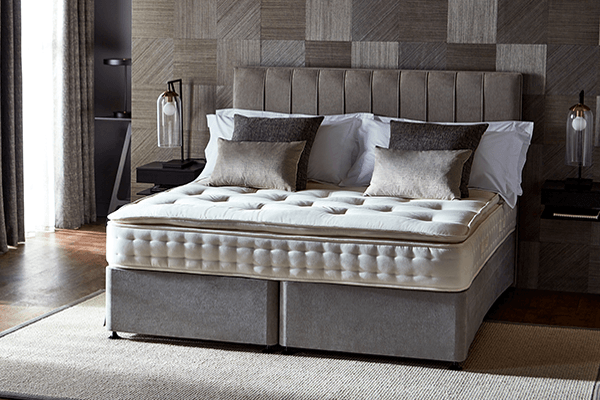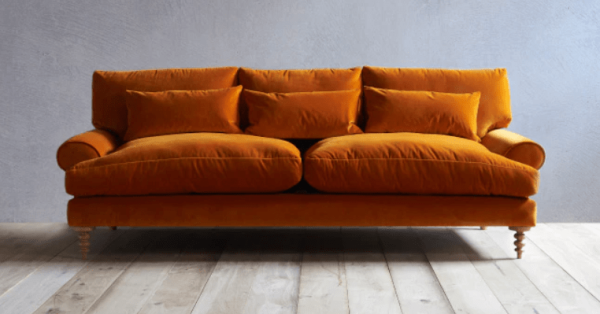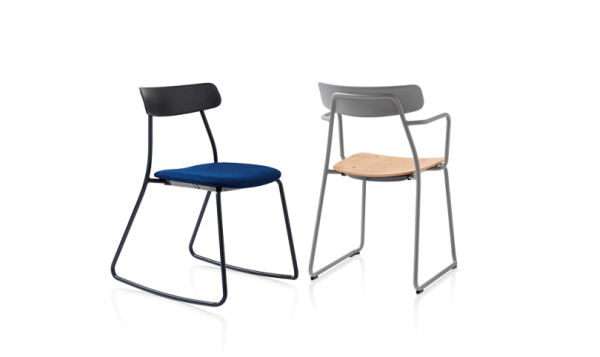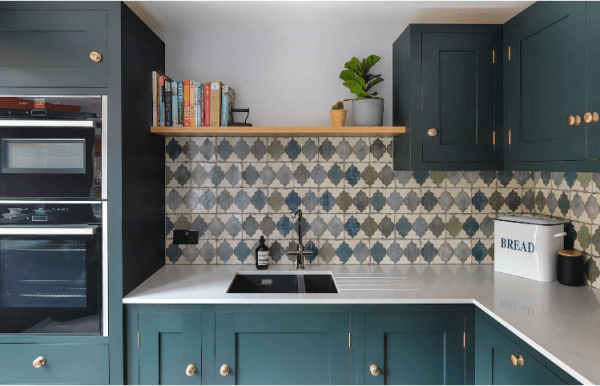The furniture industry is one of the least talked about when it comes to sustainability, but it is arguably one of the most important to embed sustainable practices into. In this blog post, we discuss what sustainability means to our industry and highlight some of the brands working to make that a reality.
Everyone is talking about sustainability! It’s a buzz word that seems to be gaining more traction, the more we learn. As a species we are looking to improve and reduce the impact we are having on the earth and every industry is under extreme pressure to prove that they are making great strides to support this.
The furniture industry is one that often gets forgotten about in favour of white goods, electricals, food, and clothing. However, the furniture industry, being one that encompasses a wide variety of products, is one that is in desperate need of our attention. After all, we are all using furniture every day and in almost every aspect of our lives.
Hypnos Contract Beds have been making impressive strides within one of the most unsustainable areas of the furniture industry, beds and mattresses. They boast to having offset and amazing 10,294 tonnes of CO2e helping them to achieve “Planet Mark – Carbon Neutral Certification”. One of my favourite of their mattresses has to be the Woolsleepers Pillow Top mattress which is “fully sustainable and recyclable”.
What is sustainability?
When we consider sustainability, we think about the environment and the impact being made on it, the energy being consumed, the emissions being produced, and the materials being made or farmed. Within the furniture industry all of these must be considered alongside costings to determine not only what the most sustainable option is, but also the most cost-effective option within this, immediately as well as over time. Companies need to think about how they design, produce, and sell their furniture in a way that minimises the environmental, social, and economic impacts while also promoting longevity for their company, processes, and products. Joanna Knight writes an interesting piece, for Design Insider (Knight, 2023), highlighting the immediate need for more sustainable thinking and routes towards a more sustainable industry.
"One of the most immediate questions that arises when companies are told that they need to be more sustainable is: why?"
Slow, a domestic sofas and chairs company in the Yorkshire Dales, have adopted a circular design process in an effort to “design timeless furniture for a sustainable future”. They take a zero-waste approach and are re-upholstery advocates, offering the service as a way to prolong the life of their products and help them to avoid landfill. I really love their Wharfe sofa which is not only handmade in the UK but is also made using sustainable, non-toxic materials.
What are the benefits of being sustainable?
One of the most immediate questions that arises when companies are told that they need to be more sustainable is why? What are the benefits?
– Lower environmental impact – through optimising production processes and transportation, greenhouse gas emissions, energy consumption, and pollution can all be reduced. This can also lead to:
§ Resource/material reduction – By focusing on maximising the use of existing resources, promoting repair, refurbishment, and recycling companies can reduce their reliance on virgin materials, therefore helping to conserve natural resources like timber, minerals, and water. In contrast, the traditional linear economy model (take-make-dispose) depletes resources rapidly.
§ Waste reduction – Furniture that is designed for longevity and can be easily disassembled and recycled or refurbished at the end of its life cycle produces less waste. This, in turn, reduces the burden on landfills and incinerators.
– Potential cost savings – By focusing on resource and waste reduction aspects this can lead to less raw materials being used and so reduces material and waste management costs. Energy efficiency within company buildings and machinery can help to reduce bills.
– Extended product lifetimes – Furniture that is built to last, reduces the need for frequent replacements. Consumers then benefit from durable products that provide long-term value. The products can be repaired, adapted, or sold/donated continuing a products lifetime, in turn reducing waste.
– Competitive edge – companies that prioritise circularity in their business models stand out as market leaders in sustainability. This, in turn, can attract environmentally conscious consumers and contribute to brand loyalty and positive public perception.
– Customer awareness and engagement – Companies promoting circularity in the furniture industry can raise awareness among consumers about the environmental and social impacts of their purchasing choices. Through engaging consumers in the circular economy companies can help to foster responsible consumption patterns.
Within the furniture industry those companies that are already making strides towards improving their sustainability need ways to highlight, prove and track their sustainable output.
Orangebox for example is doing an excellent job at highlighting the environmental impact of their products and improving the impact of the materials and practices they use. One of my favourite products that they produce is the “Acorn” café/meeting chair which demonstrates a simple but effective marrying of materials. The design boasts an amazing 99-100% recyclable content.
How can I make a difference?
It is easy enough to use google to find a free carbon footprint calculator to start understanding a company’s carbon footprint. But it is important to note that not all of these are reliable, and they don’t all calculate in the same way. Some of the tools being used to understand carbon footprint are Life Cycle Analysis and Environmental Product Declarations. Life Cycle Analysis (LCA) is a way to assess the environmental impact of a products lifecycle. Despite there being a lot of LCA tools and methods out there, they aren’t widely available to designers, the dc certification tool is a good way for brands, manufacturers, suppliers, designers, etc to reduce and report the carbon impact of their products.
(For more information on LCAs check out the blog What is Life Cycle Assessment (LCA)? – Design Conformity).
Environmental Product Declarations, which are documents that illustrate the environmental impact of a product or material over its lifetime.
Unfortunately, with these methods it is often difficult to perform a cradle-to-cradle approach as it is complicated to predict the potential route a product or material may follow unless it is all made, used and reused inhouse. This doesn’t even measure up to level of education you may feel you need just to understand what the numbers all mean once you have them!
(For more information on EPDs check out the blog Environmental Product Declaration | EPD Examples (designconformity.com).
The UN introduced the concept of “Eco Labels” an environmental label classified by the International Organisation for Standardisation. These ISO labels help consumers to understand the environmental preference of a product, based on lifecycle considerations (UN Environment Programme). Unfortunately, these aren’t currently an industry standard and so not all products are labelled, therefore limiting customer ability to compare different products/ materials.
Paperlounge is a paper furniture company with designs that are both fun and practical. The honeycomb structure utilised in all their designs allows for a product that is strong and easy to store. The project that they did with “Ritual of Karma” using their Diablo stool is a fun and simple window display that can easily be packed away and brought out again for future events or displays.
What's next for the industry?
It is currently recommended, in the UK, that companies report their scope 1 and 2 emissions. As companies start these it is becoming clearer that everyone needs to be working together.
(For more information on scope 1,2 and 3 emissions check out the blog Scope 1 | Scope 2 | Scope 3 | Emissions Reporting Calculator (designconformity.com).
There are certain emissions that aren’t controlled by the company such as electricity used by the company and the emissions from the materials manufacturers. As such communication between companies will be important. By understanding a company’s scope 1,2 and 3 emissions it can help highlight where the more sustainable designer, manufacturers, retailers, etc are. This in turn supports sustainable collaboration. This is something that is already in motion and with businesses like Design Conformity supporting the industry with an Independent Circular Design Certification they are helping to bring sustainable companies together. Making recommendations and linking together new networks.
Get certified here.
Are there any restrictions?
Despite the importance of working towards being more sustainable there are, unfortunately, many ways this can restrict a company. Firstly, and most importantly, is cost. Often, implementing sustainable practices can increase costs for the company, particularly in the short term, this is then generally passed onto the customer. Some sustainable materials are often priced higher than non-sustainable ones and if sustainable practices cause longer lead times this can also increase prices. Taking the sustainable route is a long-term process and as such going for the cheaper short-term option can cost the company more in the long run. Secondly, with higher prices this can lead to more competition from companies who aren’t sustainable as their products will be cheaper. With this a customer base may be reduced. It is easy to see why many people are put off from taking the sustainable route.
Luckily there is support out there for the companies making the decision to work on their sustainability. Particularly with the introduction of Scope 4 emissions more companies are looking for how to improve and prove they are better than their competition. Just googling for support brings up thousands of results for how to be more sustainable. More importantly there are companies, groups and networks out there that can be utilised and joined. FISP the Furniture Industry Sustainability programme in particular is a key benchmark for sustainability with the UK furniture industry. Not only do they improve competitiveness and cost effectiveness, but they help companies work towards awards, gaining industry recognition. The Sustainable Design Collective (SDC) is a think tank that aims to promote knowledge sharing and reduce climate impact. Though they predominantly work within the office furniture sector, the information and knowledge generated could be applied across the sector.
The Furniture Makers Company, a livery company and charity for the British furniture industry, support their members by hosting regular sustainable events to discuss what is currently being done and how they industry can improve and move forward sustainably. Their next event “Climate Change Sprint Challenge” on 4th October aims to discuss a variety of topics including Avoiding harm to people and planet; Standards & certification; Measuring & reducing carbon emissions; Prioritising material selection; Circular Economy – keeping products & materials in circulation. (FMC)
"At the end of the day everyone needs to be working on being more sustainable, employing circular economy tactics, and making their products last."
I am a big kitchen fan! They are a big focal point in many homes and yet we want to change what we have constantly, whether that is due to style changes or damage. Sustainable Kitchens is a bespoke kitchen company specialising in providing sustainable kitchens. They have some fantastic designs that are simple, well made, and easy to renovate, plus the materials are all sustainably sourced. My favourite of their projects has to be the “Bristol Shaker Kitchen” which offers a classic, yet contemporary feel. Plus, if you got bored of the colour you can always strip it down and/or paint it!
At the end of the day everyone needs to be working on being more sustainable, employing circular economy tactics, and making their products last. Cost will always be one of the biggest factors holding companies back, however if the investment isn’t made now, it will hold them back and potentially cause more costs, problems and even loss of customers in the future.
Let’s work together to make our industry sustainable!!
The dc Circular Design Certificate allows companies to report their carbon footprint, but more importantly it benchmarks their carbon efficiency and encourages manufacturers to offer more circular products, products that can reduce carbon impact by allowing for reuse or recycling.
To find out more about carbon efficiency click here.

Katie Furmston
Head of Design & Research
References:
https://www.hypnoscontractbeds.com/uk
https://www.hypnoscontractbeds.com/uk/our-beds/hospitality-mattresses/woolsleepers-pillow-top
https://www.designinsiderlive.com/a-lifecycle-approach-the-key-to-innovative-sustainability/
https://slowsofa.co.uk/pages/sustainable-furniture-uk
https://slowsofa.co.uk/products/wharfe
https://www.orangebox.com/products/acorn
https://www.paperlounge.co.uk/
https://www.paperlounge.co.uk/pages/visual-merchandising-displays
https://www.fispfurniture.com/about-fisp
https://thesustainabledesigncollective.co.uk/
https://www.furnituremakers.org.uk/events/climate-change-sprint-challenge/
https://www.sustainablekitchens.co.uk/
https://www.sustainablekitchens.co.uk/the-bristol-shaker-kitchen/
#sustainablefurniture #carbonfootprintcalculator #productlifecycleassessment #sustainablefurnitureuk #sustainabilityinretail #cradletocradlelifeassessment











